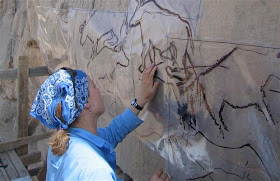Long-forgotten Canadian find shakes up understanding of ancient humans
By Randy Boswell, Postmedia News
November 18, 2011
A Canadian archeologist is being credited — nearly 50 years after the fact — with discovering a prehistoric petroglyph site in southern Egypt that is now being described as a "Lascaux-on-the-Nile" because of its similarity in age and style to France's world-famous, cave-wall gallery of Stone Age cattle, deer and horses.
The inscribed Egyptian images of extinct wild oxen, hippopotami, fish, gazelle and other animals — now firmly dated to a time in the late Pleistocene era at least 15,000 years ago — are being hailed as the oldest rock art in North Africa and as a pivotal discovery in the evolution of artistic behaviour by ancient humans.
 |
Prehistoric petroglyph site in southern Egypt discovered by Canadian archeologist Philip Smith in a 1962-63 expedition.
Photograph by: Handout, Yale University |
That's where the young Canadian scientist Philip Smith — a University of Toronto archeologist from Fortune, N.L. — was working in 1962 and 1963 as part of a federally sponsored series of "rescue" digs aimed at preserving traces of ancient Egyptian settlements before their potential destruction from the building of the Aswan Dam.
Smith, who went on to a distinguished 40-year career at the University of Montreal, was probing an archeological site from thousands of years before the Egyptian pyramids were built when he "accidentally" discovered the carvings at Qurta.
Now 84 and long retired from archeological field work, Smith told Postmedia News on Thursday that he remembers scrambling up the cliffs to take a photograph of a dig site on the plain below when he suddenly spied scores of animals carved into the rocks.
"They were everywhere on the rock," Smith said. "But we weren't able to date it directly. At that time there was no way of dating art on the cliffs themselves."
He recalls, though, that he "speculated that it was certainly pre-pharaohnic — before the pharaohs — and probably pre-neolithic, before the introduction of agriculture. But, of course, I wasn't able to go much further back than that."
A lengthy article about the work of the Canadian Prehistoric Expedition in Egypt appeared in a 1965 issue of the Canadian Geographical Journal, forerunner of today's Canadian Geographic. Descriptions and pictures of the prehistoric rock art at Qurta were published at the time, but Smith was never able to pin down a solid date for when the carvings were made — and conventional wisdom about the evolution of art in the ancient world held that paleolithic Europe was almost certainly the seedbed of advanced human creativity.
Years passed. Then decades. No further study of the Qurta animal engravings was carried out, and even knowledge of their whereabouts was lost to a younger generation of scientists.
Then, about five years ago, Belgian archeologists working on paleolithic sites in Egypt found evidence of prehistoric rock art at a different site and began a broader study that turned up the Canadian research at Qurta from the early 1960s.
That led to the latest research on the Qurta carvings, to be published in the December edition of the journal Antiquity by a team of scientists from Belgium and the U.S.
They used a process called "optically stimulated luminescence" to test the wind-blown sediments accumulated on the etchings to determine the last time the most deeply buried grains of sand were exposed to sunlight.
Their study pegs the creation of the artwork at between 15,000 and 19,000 years ago. That places the Egyptian carvings in roughly the same timeframe as the famous cave paintings of animals at Lascaux and other Ice Age sites in Europe.
"The paleolithic rock art at Qurta reveals that the well-known cave art of the late Pleistocene in Europe was not an isolated phenomenon," study co-author John Coleman Darnell, a Yale University professor of Egyptology, states in a summary of the study. "Qurta puts North Africa firmly in the world of the earliest surviving artistic tradition, and shows that tradition to have been geographically more widespread than heretofore imagined."
The paper to be published in Antiquity suggests the fresh understanding of the Egyptian artwork first identified by Smith could force a major rethinking of the origins of art and the connections between Stone Age people in Europe and North Africa.
"Whereas it would be premature to speculate on any implications of this in terms of long-distance influence and intercultural contacts," the authors conclude, "it is clear that the Pleistocene age of the Qurta petroglyphs — as demonstrated by the present study — along with their degree of sophistication, similar to that of European Ice Age art, introduce a new set of challenges to archeological thought."
Smith, whose other work at ancient aboriginal digs in the U.S. and at paleolithic sites in Spain and France continues to generate interest among today's archeologists, said he's equally pleased his Egyptian find is still yielding new insights today.
"It is," he said, "very gratifying."
(c) Postmedia New
No comments:
Post a Comment